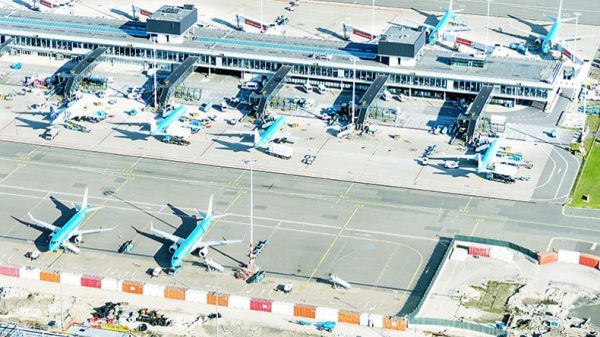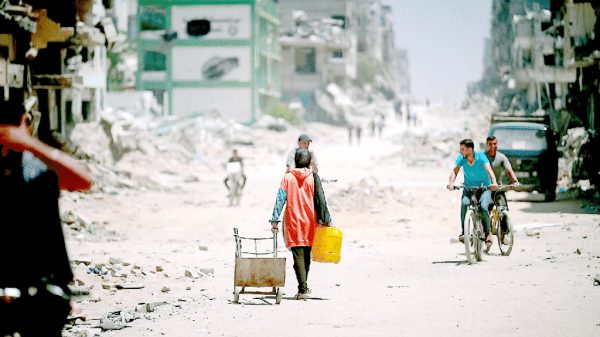Is there some light at the end of the tunnel?

Touhid Shipar Rafiquzzaman
THE world has not experienced such an unprecedented impact caused by the ongoing Covid pandemic since the Spanish flu of the 1920s. It has touched every business, industry and human life equally, whether through the loss of sales or jobs. The aviation industry was no exception and was clearly one hit the hardest, witnessing an extremely turbulent time since Covid-19 2019 in late 2019. As the world returns to the new normal amidst the reopening of businesses, industries, educational institutions and relaxed travel measures, the aviation industry struggles to bounce back to pre-pandemic levels. Nevertheless, it is not all gloom and doom for the aviation industry.
Experiencing the devastating impact of the virus both in terms of death and infection, which were spreading fast and wide, most countries across the world enforced lockdown and travel restrictions to contain the disease. Since the beginning of the second quarter of 2020, air travel was almost non-existent; and as a result, most airlines were compelled to ground their fleet. Given the burgeoning pandemic manifesting in multiple waves during that period, the airlines were forced to significantly reduce staff, cancel aircraft orders, limit destinations, accelerate the retirement of both human resources and aircraft and rationalise administrative costs. Safety concerns at the consumer level also reduced demand for travel. Subsequently, several airlines either declared bankruptcy or ceased operations while a few airlines undertook mergers or acquisitions.
Hence, the airline industry like most other businesses was one of the most impacted. This not only reduced holiday travels for leisure, but also disrupted world trade and global supply chains, having a domino effect on other industries as well. At the outset, the impact on the industry is alarming and is evident from the reduction in revenue from this sector which declined by 56 per cent from $818 billion in 2019 to $359 billion in 2020. It is projected to record a revenue of $472 billion and a net loss of $52 billion in 2021, a marginal recovery, yet with a long way to go. These figures include both passengers and cargo transport from scheduled and non-scheduled routes. The International Air Transport Association forecasts about 50 per cent below than the pre-pandemic period in the current year and is not expected to return to the 2019 levels till 2024.
Both large and small airlines faced severe headwinds in terms of survival. As of 2019, the largest airline by passengers carried and fleet size was the American Airlines Group, while Delta Air Lines was the largest by revenue and market capitalisation. The Lufthansa Group was the largest by the number of employees, FedEx Express by freight tonne-kilometres, Turkish Airlines by the number of countries served and UPS Airlines by the number of destinations operated although United Airlines was the largest passenger airline by the number of destinations served. Even these major airlines like many others worldwide regardless of their size had to undertake a severe restructuring of personnel, fleet size, network and overall cost efficiency to stay afloat during this difficult period.
Cost continues to be a challenge to airlines as they attempt to recover the lost grounds of pre-2019 levels. The increase in cost for airlines is evident this year given the increase in fuel price. Fuel, which was hovering around $45–$50 per barrel, has shot up to $75–$80 per barrel. However, other costs including non-fuel costs will decrease in 2021 at the back of a slight improvement in capacity use and an increased number of destinations in comparison with 2020. The IATA forecasts a 15 per cent decline in this segment. Table 1 shows a comparative analysis of three years of performance of airlines globally that shows signs of marginal improvement.
Business travel almost came to an absolute halt during all of 2020 and the first six months of 2021. Corporate travel, accounting for around 12 per cent of airlines’ passengers though, contributes circa 75 per cent of the profit as businesses book last minute point-to-point and flexible tickets as well as much more expensive Business and first-class seats. Zoom and MS teams have also posed a challenge for airlines businesses as people prefer the convenience of using technology for meeting and conferences as opposed to face-to-face encounters given the Covid situation. Seamless business operations over the past year and a half have shown that the added hassle and costs of travel can be avoided unless absolutely necessary. Conferences and trade shows, which account for a significant volume of business trips, have remained virtual for the most part of the past 18 months.
Travel restrictions, strict Covid quarantine rules, slow vaccination roll-out in many parts of the world and lack of business/corporate travel, if prolonged, will continue to have a negative impact on the overall aviation industry going forward. However, there are signs of improvement in non-business or leisure travel picking up worldwide, essentially with increased vaccination and relaxed Covid protocols. It is no all Armageddon now, which is also evidenced from the increased delivery of aircraft as per Table 2.
Furthermore, there seems to be some light at the end of the tunnel as far as the cargo business is concerned in 2021. The rebound of the larger economies, gradual opening of borders, vaccinations taking pace and increased world trade have benefited the cargo business of airlines’ operations. The cargo business is already operating at 8 per cent above pre-crisis levels. Air cargo has been a lifeline for many airlines — delivering vaccines, personal protective equipment, medical equipment and even e-commerce. In doing so, it has become the star performer for many airlines in the industry. Cargo businesses as a rule of thumb usually account for around 10–15 per cent of the total revenue which now stands at a third because of severe reduction in passenger travels. It is forecast to reach $152 billion in 2021, according to IATA, that is almost a third of the revenue projected, thereby compensating the passenger sales for the time being.
Clearly, at the back of such devastation and slow recovery to reach pre-pandemic levels, government financial intervention was necessary at this critical juncture to overcome this uncertain period. Government financial support for airlines played a key role in limiting bankruptcy filing. Additionally, some governments injected billions of dollars to keep the airline afloat during this pandemic. This assistance albeit came with a few conditions which were difficult to comply with. State assistance was extended in different forms and tenors, including but not limited to equity injections, loans, guarantees, deferred payment of taxes and reduction of tax liabilities. In some cases, government extended salaries to save jobs. As of September 2021, government aid totalled $243 billion, as shown in the chart.
Some airlines have received aid with inflexible caveats and may have foregone a few of their operational and marketing advantages. In a revival situation, de-carbonisation targets, key personnel retention policies, competitive air fares, controls on share buybacks will restrict flexibility and an increase in overall debt obligations. Added government ownership is likely to experience operational interference. As airlines begin to generate revenue once more, they will look forward to refinancing the more confining government loans. However, this may be a small price to pay for what might have been the alternative reality.
Unfortunately, a few large airlines in many territories have been deprived of government monetary funding and had to raise debts in their already leveraged balance sheets while many smaller airlines are in distress in 2021 without any state subsidy as lenders’ payment forbearance begins to expire. Some African, Latin American and a few least developed countries did not, or could not, extend financial support for their airlines because of their own limitations while airlines in the Untied States, Europe and parts of Asia have generally received a substantial government support. Predicting a retrieval environment over a year or two, this uneven playing field will play a pivotal role in shaping the future of the aviation industry.
Governments across the world have continued to support airlines as the impact of the pandemic has been overwhelming and longer than expected. This support has prevented widespread airline failures in 2021, as was the case in 2020. Indeed, the financial support from governments remains critical for the survival for a few airlines. While governments initially intended to support these airlines on a temporary basis till the travel environment improved, given the potential resurgence of the pandemic now being witnessed in many parts of the globe, governments are compelled to continue their commitments long term.
The airlines industry is cautiously optimistic of better times ahead and needs to operate carefully in order to traverse, subsist and withstand.
— An extremely comforting factor in this rather depressing situation has been the reduction in air pollution levels due to very limited aircraft taking on the sky. The pollution level is expected to remain lower compared with pre-pandemic times even if air travel goes up in near future. The reduction in air pollution will be instrumental in contributing to the global goal of reducing carbon emissions to an acceptable level.
— With the world witnessing the slump of the pandemic and countries opening their borders for international travellers both in terms of business and tourism, it is expected that airlines will recover gradually over the next year and a half or two but will not reach the 2019 levels just as yet.
— The good news is, however, the improvement in their cargo business. It is already showing signs of better performance than 2019 and is expected to register a robust business in 2022 and beyond. The increase in the delivery of aircraft is indicative of the improved situation for the aviation industry.
— Given the increased vaccination drive worldwide, it is expected that more and more countries will entertain visitors, relax Covid protocols and the resumption of businesses and industries will gain momentum. This will certainly benefit the aviation sector to great levels.
— Important and absolutely vital was the financial support it derived from the respective governments which totalled to an impressive $243 billion and expects it to be continued over a long period of time with minimal terms and conditions.
Touhid Shipar Rafiquzzaman is a retired banker.
:




























Leave a Reply